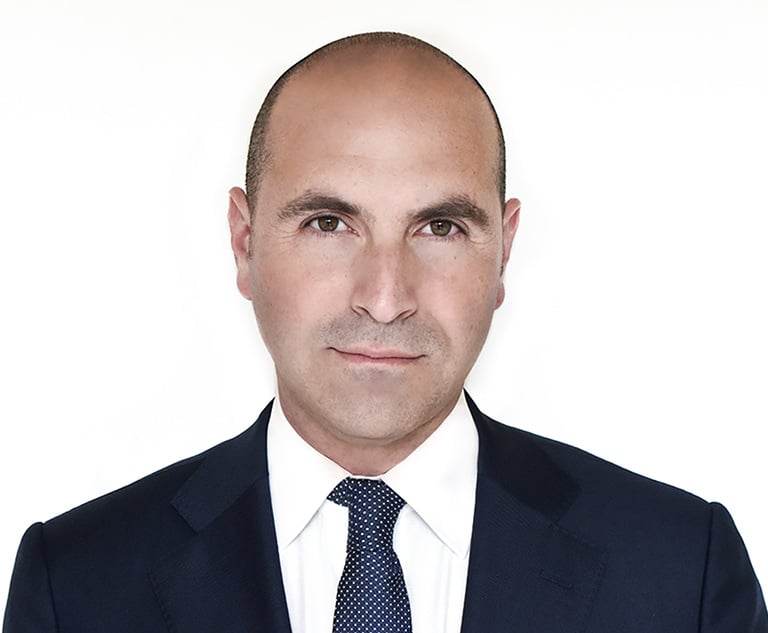Big Spenders: Some Florida Bankruptcy Cases Are Costing More Than $1 Million to Administer
Bankruptcy doesn't come cheap, according to an independent study by ALM's Daily Business Review.
March 29, 2019 at 04:28 AM
12 minute read
 (l-r) Kristopher Aungst, Thomas Messana, and Alen Hsu worked on some of South Florida's most expensive bankruptcy cases since 2016. Courtesy photos.
(l-r) Kristopher Aungst, Thomas Messana, and Alen Hsu worked on some of South Florida's most expensive bankruptcy cases since 2016. Courtesy photos.
Editor's note: This is the third in a series of stories taking a deep dive into the U.S. Bankruptcy Court for the Southern District of Florida.
At least 30 cases in South Florida bankruptcy court have cost more than $1 million to litigate in the past three years, raising questions about whether trustees and other professionals are treating creditors' money as though it were their own.
The answer: Not always, according to Robert Kaye, a partner at Pompano Beach-based Kaye Bender Rembaum.
“Bankruptcy is where it goes off the rails,” he said. “Things get complicated.”
Kaye isn't a bankruptcy lawyer. He represents Florida condominium and homeowners' associations, and his firm found itself a creditor in litigation against a former client refusing to pay $80,000 for four years of legal services.
When the client, Spanish Isles Property Owners Association Inc., filed for Chapter 11 bankruptcy protection, trustee Margaret J. Smith filed suit against Kaye's firm. The complaint accused Kaye Bender of negligence that contributed to the association's financial woes.
Court documents show that to wipe out the alleged $80,000 Kaye Bender debt, Smith spent more than six times that amount, or about $500,000, on litigation that the court ultimately dismissed with prejudice — but not until the alleged underlying debt climbed to about $130,000, thanks to additional fees and expenses.
“I don't know the motivation of why they felt it was so important to spend so much money on themselves and their attorneys,” Kaye said. “Our attorney said his opinion was we were facing what amounted to legal extortion.”
Related story: South Florida Lawyers Are Raking In Millions Working in Bankruptcy Court
Smith did not respond to requests for comment by deadline.
But attorneys insist the hefty billings in bankruptcy court have merit.
$11 Million and Counting
The most expensive case in the Southern District of Florida between 2016 and 2018 was a Florida hedge fund's Chapter 11 bankruptcy. It's cost more than $11 million in the last three years, paid to attorneys and other professionals, according to an independent study by ALM's Daily Business Review.
But $11 million is just a fraction of the cost of the case, which began in 2009 and stemmed from the third-largest Ponzi scheme in U.S. history, which affected Palm Beach Finance Partners L.P. and Palm Beach Finance II L.P.
 Fee examiner Maria Sawczuk of Goldstein & McClintock's Delaware office. Courtesy photo.
Fee examiner Maria Sawczuk of Goldstein & McClintock's Delaware office. Courtesy photo.Bankruptcy lawyers live by a code, requiring them to defend their fee claims before the court, which can reject them or request reductions, depending on the facts of a case, according to fee examiner Maria Sawczuk of Goldstein & McClintock's Delaware office.
Sawczuk is appointed to examine professionals' fee applications, questioning their accuracy and reasonableness. She oversaw fees in guitar company Gibson Brands Inc.'s Chapter 11 bankruptcy, which she said has racked up similar costs to South Florida's most expensive case in less than a year. The Gibson case moved quickly, lasting less than 12 months, meaning more attorneys and professionals charging overtime.
But back in Florida, attorney Michael S. Budwick worked on the most expensive bankruptcy case on the docket in the state's southern district.
Budwick, of Meland, Russin & Budwick, represents Palm Beach Finance Partners L.P., which lost $650 million to the scheme. He said he was proud of the numbers in the case as the company had $6.06 in its bank account when he was hired for what became the most challenging case of his career.
“After diving into the documents, interviewing witnesses, assembling a team of experts, filing 140 lawsuits, taking over 125 depositions across the country and numerous mediations, we've recovered over $210 million, including $85 million from banks and professionals,” Budwick said.
Adding to that, Budwick's team landed a $49 million settlement Tuesday with GE Capital, accused of joining the fraud.
Which cases cost the most?
The second most expensive case on the docket during that period stemmed from the 2012 Chapter 11 proceedings for Majorca Isles Master Association Inc., a 55-unit Miami Gardens community crippled by poor cash flow.
In 2016, trustee Barry E. Mukamal sued developer D.R. Horton over alleged deceptive practices — landing a $16.3 million judgment that eventually became an $11 million settlement.
At least 15 attorneys worked on the case, which has cost almost $7 million in the last three years.
Click here to read the most recent financial report for Majorca Isles
Almost among the top fee generators: The 2016 bankruptcy of Boca Raton-based life settlement company Mosaic management Group Inc., which has cost more than $4 million, making it the sixth most expensive.
Mosaic bought life insurance policies to carve up for investors worldwide, but it had major management problems, and those covered by its policies were living longer than expected.
Counsel to Mosaic, Kristopher E. Aungst of Wargo French — the 13th highest biller in the court — spent months on the “delicate” task of encouraging bickering investors across the world to come together.
“To get 2,700 creditors all pointing in the same direction, agreeing with your plan was really difficult,” Aungst said.
Many attorneys, Aungst included, claim that less money would be recovered for creditors if the professionals involved weren't so specialized and, therefore, expensive.
“A lot of times, when a business comes to me, the problems they've had have festered for a long period of time,” Aungst said. “It's not as simple as saying, 'Oh, we'll just do A, B and C, and it'll be fine.' It's a complete restructuring, recapitalization and undoing of a company that had issues, and it allows them to regroup, rebuild, get a fresh start and continue on.”
One such case: the Chapter 7 bankruptcy of Claudio E. Osorio, a Venezuelan businessman convicted of defrauding investors, and his wife Amarilis M. Osorio, was the ninth most costly. The litigation has involved 16 attorneys, who've billed more than $3 million in three years.
Related story: South Florida Lawyers Are Raking In Millions Working in Bankruptcy Court
One mall, 11 attorneys
The third most expensive bankruptcy began with the defunct Fashion Mall in Plantation and became a saga in its own right. Since 2016, it has cost $5.9 million and involved at least 11 lawyers.
The property's manager Chinese investor Wei Chen put its operating companies in bankruptcy proceedings in 2014 because of infighting with business partner, Zhen Zeng Du. According to one of Chen's lawyers, Alen Hsu of Weiss Serota Helfman Cole & Bierman, his client chose bankruptcy as he couldn't focus on redeveloping while legal battles depleted the business.
But once in bankruptcy court, bankruptcy trustee Kenneth Welt saw the case differently. He sued Chen and his family members, alleging fraudulent transfers and seeking more than $10 million. Chen later popped up on an Interpol economic fugitive list released by the Chinese government — something Chen maintained was a set up to tarnish his reputation. Chen was removed from the list, but it wasn't easy getting past that negative connotation, according to Hsu.
“Everybody thought my client was a Madoff or a Rothstein that had looted and depleted these entities, when it was completely not true,” Hsu said.
 Fashion Mall. Photo: ALM.
Fashion Mall. Photo: ALM.Related story: Would-Be Fashion Mall Developer on China's Most Wanted List
Hsu, retained in 2015, said it's unfortunate that the case cost so much. He helped negotiate a settlement that allowed Chen to keep a $1 million flower shop.
“We wish we could have resolved it sooner. Even the trustee wanted to resolve it sooner, it's just we were unable to,” he said. “It's unfortunate that something like this went as far as it did and as much fees were incurred, but in this matter it was something that was absolutely necessary.”
Hsu said his client was “extraordinarily upset” with Welt's lawsuits and spending.
“I thought the trustee did a good job, but my client felt completely otherwise,” Hsu said. ”I could see why the trustee felt the way they felt, but I can tell you my client felt this was a complete sham lawsuit. He thought he was being set up by Mr. Du and at one point he couldn't be more upset with the lawsuit. And unfortunately, he had to spend a lot of money on attorney fees to vindicate himself.”
According to Hsu, it was hard to keep costs low when all stakeholders and partners were Chinese and spoke little to no English. That meant depositions, and most of the 1 terabyte worth of documents, text messages and emails had to be translated.
Trustee Welt sold the mall for $37.7 million at auction, where it had a $24 million stalking horse bid — meaning that would be considered the highest and winning bid if no competition emerged.
The total debt was more than $95 million, but Welt distributed more than $28 million to creditors. Another $1 million distribution is likely, according to his lawyer Glenn D. Moses of Genovese, Joblove & Battista.
By April 2018, trustee's attorney Moses had incurred $3.3 million in fees when he asked the court for an additional $1.3 million.
According to the trustee's most recent fee application, the partners and associates involved spent about 3,028 hours on the case and, on average, charged $432 an hour between March 1, 2017 and March 31, 2018. In that time, the team resolved eight adversary proceedings.
Moses worked the most hours — 842 — followed by partner Greg M. Garno with 600 hours, then associate Martin J. Keane with 375. Six paralegals spent a combined 382 hours on the case that year, according to the report.
Moses spent some of his time — 242 hours — working on claims administration and objections, which translated into $127,102 in fees.
According to fee examiner Sawczuk, it's rare that nothing is out of whack in a fee application, usually because of calculation errors.
“I've seen where that kind of stuff just takes too long and it shouldn't, or it's being done by someone too senior,” Sawczuk said. “Sometimes you have to have that senior person do it but they shouldn't be charging their senior rates.”
The goal is to push work down as far as possible, to the person capable of doing the work at the lowest rate, according to debtor's counsel Thomas M. Messana.
“Not everything needs to be done by a partner,” Messana said. “And if they're done by partners then they should be more efficient. One of the reasons we charge more an hour is because we should take less time doing it.”
It's best to “blend” a team, according to Messana, having junior lawyers do the everyday grafting, then having senior co-workers add value by overseeing their work.
In bankruptcy world, a big case often makes up for multiple stinkers, according to Sawczuk.
“If you're a trustee you may have 10 cases that are losers because there's not enough money in the case to get you a fee, then you hit the one that actually has assets and you sell them for a couple million dollars and you get your huge fee,” Sazczuk said. “So it might be a little deceptive in that respect.”
The Fashion Mall case was unique, according to Jerry M. Markowitz, managing shareholder with Markowitz Ringel Trusty + Hartog, who also represented Chen. He billed $74,861 over three years.
“Cases like the Fashion Mall are very, very unusual in the bankruptcy arena in that it is a rare case where creditors are paid in full and the money gets distributed to equity,” Markowitz said. “In my career of over 40 years there may have been a handful of cases like that.”
Samantha Joseph contributed to this report.
Related stories:
Attorneys for Embattled Chinese Businessman Speak on Fashion Mall Settlement
Lawsuit Against GE Capital Over Petters Ponzi Scheme Heads to Trial
This content has been archived. It is available through our partners, LexisNexis® and Bloomberg Law.
To view this content, please continue to their sites.
Not a Lexis Subscriber?
Subscribe Now
Not a Bloomberg Law Subscriber?
Subscribe Now
NOT FOR REPRINT
© 2025 ALM Global, LLC, All Rights Reserved. Request academic re-use from www.copyright.com. All other uses, submit a request to [email protected]. For more information visit Asset & Logo Licensing.
You Might Like
View All
Financially Grounded: South Florida-Based Silver Airways Files for Bankruptcy


US Judge Throws Out Sale of Infowars to The Onion. But That's Not the End of the Road for Sandy Hook Families
4 minute read
Growing Referral Network, Alternative Fees Have This Ex-Big Law’s Atty’s Bankruptcy Practice Soaring
5 minute readTrending Stories
- 1The End of Innocence? DEP’s End Run Around ‘All Appropriate Inquiry’ Spill Act Protections
- 2Pistachio Giant Wonderful Files Trademark Suit Against Canadian Maker of Wonderspread
- 3New York State Authorizes Stand-Alone Business Interruption Insurance Policies
- 4Buyer Beware: Continuity of Coverage in Legal Malpractice Insurance
- 5‘Listen, Listen, Listen’: Some Practice Tips From Judges in the Oakland Federal Courthouse
Who Got The Work
J. Brugh Lower of Gibbons has entered an appearance for industrial equipment supplier Devco Corporation in a pending trademark infringement lawsuit. The suit, accusing the defendant of selling knock-off Graco products, was filed Dec. 18 in New Jersey District Court by Rivkin Radler on behalf of Graco Inc. and Graco Minnesota. The case, assigned to U.S. District Judge Zahid N. Quraishi, is 3:24-cv-11294, Graco Inc. et al v. Devco Corporation.
Who Got The Work
Rebecca Maller-Stein and Kent A. Yalowitz of Arnold & Porter Kaye Scholer have entered their appearances for Hanaco Venture Capital and its executives, Lior Prosor and David Frankel, in a pending securities lawsuit. The action, filed on Dec. 24 in New York Southern District Court by Zell, Aron & Co. on behalf of Goldeneye Advisors, accuses the defendants of negligently and fraudulently managing the plaintiff's $1 million investment. The case, assigned to U.S. District Judge Vernon S. Broderick, is 1:24-cv-09918, Goldeneye Advisors, LLC v. Hanaco Venture Capital, Ltd. et al.
Who Got The Work
Attorneys from A&O Shearman has stepped in as defense counsel for Toronto-Dominion Bank and other defendants in a pending securities class action. The suit, filed Dec. 11 in New York Southern District Court by Bleichmar Fonti & Auld, accuses the defendants of concealing the bank's 'pervasive' deficiencies in regards to its compliance with the Bank Secrecy Act and the quality of its anti-money laundering controls. The case, assigned to U.S. District Judge Arun Subramanian, is 1:24-cv-09445, Gonzalez v. The Toronto-Dominion Bank et al.
Who Got The Work
Crown Castle International, a Pennsylvania company providing shared communications infrastructure, has turned to Luke D. Wolf of Gordon Rees Scully Mansukhani to fend off a pending breach-of-contract lawsuit. The court action, filed Nov. 25 in Michigan Eastern District Court by Hooper Hathaway PC on behalf of The Town Residences LLC, accuses Crown Castle of failing to transfer approximately $30,000 in utility payments from T-Mobile in breach of a roof-top lease and assignment agreement. The case, assigned to U.S. District Judge Susan K. Declercq, is 2:24-cv-13131, The Town Residences LLC v. T-Mobile US, Inc. et al.
Who Got The Work
Wilfred P. Coronato and Daniel M. Schwartz of McCarter & English have stepped in as defense counsel to Electrolux Home Products Inc. in a pending product liability lawsuit. The court action, filed Nov. 26 in New York Eastern District Court by Poulos Lopiccolo PC and Nagel Rice LLP on behalf of David Stern, alleges that the defendant's refrigerators’ drawers and shelving repeatedly break and fall apart within months after purchase. The case, assigned to U.S. District Judge Joan M. Azrack, is 2:24-cv-08204, Stern v. Electrolux Home Products, Inc.
Featured Firms
Law Offices of Gary Martin Hays & Associates, P.C.
(470) 294-1674
Law Offices of Mark E. Salomone
(857) 444-6468
Smith & Hassler
(713) 739-1250






